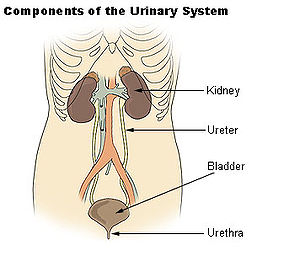- Osmotic diuresis
-
Osmotic diuresis is increased urination caused by the presence of certain substances in the small tubes of the kidneys.[1] The excretion occurs when substances such as glucose enter the kidney tubules and cannot be reabsorbed (due to a pathological state or the normal nature of the substance). The substances cause an increase in the osmotic pressure within the tubule, causing retention of water within the lumen, and thus reduces the reabsorption of water, increasing urine output (ie. diuresis). The same effect can be seen in therapeutics such as mannitol, which is used to increase urine output and decrease extracellular fluid volume.
Substances in the circulation can also increase the amount of circulating fluid by increasing the osmolarity of the blood. This has the effect of pulling water from the interstitial space, making more water available in the blood and causing the kidney to compensate by removing it as urine. In hypotension, often colloids are used intravenously to increase circulating volume in themselves, but as they exert a certain amount of osmotic pressure, water is therefore also moved, further increasing circulating volume. As blood pressure increases, the kidney removes the excess fluid as urine.
Sodium, chloride, potassium are excreted in Osmotic diuresis, originating from Diabetes Mellitus (DM). Osmotic diuresis results in dehydration from polyuria and the classic polydipsia (excessive thirst) associated with DM.
See also
References
- ^ Ganong, William F. (2005). Review of Medical Physiology. McGraw-Hill Professional. pp. 719. ISBN 0071440402. http://books.google.com/books?id=OLa8vDBXDD4C&pg=PA719&dq=%22Osmotic+diuresis%22&as_brr=3&sig=ACfU3U3_zgU5V59jPWEcho-0M6fBljuvdg.
External links
Categories:- Nephrology
- Medicine stubs
Wikimedia Foundation. 2010.

